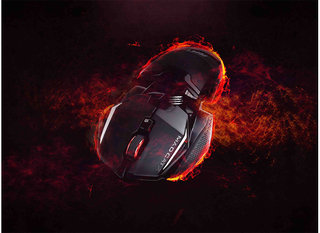LAS VEGAS, NV -- Although CES 2018 wasn’t the first time we’ve seen a mouse with wireless charging--Logitech beat everyone to it last year when it released Powerplay--it was the first time we saw it from many manufacturers. It seems we have a veritable trend on our hands (well, under our hands), as this year Corsair, Razer, and the newly revived Mad Catz all showed off their own flagship mice featuring wireless power and connectivity. What’s more, they’ve all taken their own strategy with it.
Corsair


Corsair used CES 2018 to launch the finalized, production version of its earlier-previewed Dark Core mouse with Qi wireless charging. Like Logitech’s Powerplay, this mouse is wirelessly charged, so it still has an internal battery. Qi charging differs from Powerplay, however, in that it can’t work if the mouse is moving. The Dark Core will have to be parked over a specific spot on the Qi mouse pad to charge. The advantage of Qi, beyond being able to charge the mouse faster than Powerplay, is that it can also charge other compatible devices, such as phones. Corsair is pushing this advantage by including a Qi charging dongle with its Qi mousepad.
Mad Catz

Mad Catz returned from the dead to reveal its wireless R.A.T. Air. This one is similar to the Razer Hyperflux in that it’s wirelessly powered and has no battery, so it can’t leave the pad without a cable (although it will remain powered for 20-30 seconds, so lift-off won’t be an issue). Like the Razer, the Air’s mousepad is proprietary, dual-sided, and RGB-lit.
Disappointingly, it loses a lot the old R.A.T. mice’s customizable parts--only its palm grip is adjustable for length. Mad Catz’s argument for getting rid of the battery is not convincing; it claimed the battery adds unnecessary heat to the mouse. There’s a simpler reason, though: The revived R.A.T. series needs a wireless flagship, so why not make it a wirelessly powered one?
Razer







Razer revealed the Mamba Hyperflux, and it’s a totally different beast. In an effort to reduce weight--those batteries do tend to add some heft--as evidenced by the Corsair Dark Core’s 128g weight--Razer got rid of the battery altogether. The Mamba Hyperflux, then, doesn’t charge; it only works when it’s on top of its proprietary Firefly Hyperflux mousepad (which uses inductive charging). The mouse still has about 10 seconds of power buffer in case of lift-off, though.
If you’re not into lightweight mice (at 96g, the Mamba Hyperflux is definitely on the lighter side), then there doesn’t seem to be any advantage to this. On the other hand, if you want wireless connectivity and charging without dragging around a heavy mouse, then this is going to be one of your only wireless options.
| Product | Dark Core RGB SE | Razer Mamba Hyperflux | R.A.T. Air |
|---|---|---|---|
| Sensor | PMW3367 (Optical) | Razer 5G optical | PIXART PMW3360 (Optical) |
| Resolution | Up to 16,000 DPI | Up to 1,6000 DPI, 450 IPS | Up to 12,000 DPI |
| Ambidextrous | No (right-handed only) | No (right-handed only) | No (right-handed only) |
| Switches | Omron (main mouse buttons only) | Razer mechanical | Unknown |
| Polling Rate | 1,000Hz | Up to 1,000Hz | Up to 1,000Hz |
| Lighting | 3-zone RGB 16.8M colors | RGB 16.8M colors | None |
| Buttons | 9 | 9 | 10 |
| Software | Corsair CUE | Razer Synapse | Mad Catz Flux |
| Cable | WirelessUSB | WirelessUSB | WirelessUSB |
| Dimensions (H x W x D) | 126.8 x 89.2 x 43.2mm | 124.7 x 70.1 x 43.2mm | Unknown |
| Weight | 128g | 96g | Unknown |
| Price | $90 | $250 (Firefly Hyperflux mousepad included) | Unknown |
Stay on the Cutting Edge
Join the experts who read Tom's Hardware for the inside track on enthusiast PC tech news — and have for over 25 years. We'll send breaking news and in-depth reviews of CPUs, GPUs, AI, maker hardware and more straight to your inbox.
-
canadianvice IMO the Qi mousepad is kind of a dolt idea... I mean, it makes sense for the mouse when it needs to be recharged, but really the only reason I see to pay the extra for one of these "true-wireless mice" is if they can charge while in use, such as with the powerplay offering from Logitech.Reply
If people need another qi appliance - they're far cheaper as the basic pads with the same level of functionality; even if your mouse has to sit still, there's not much of a difference except for it being a pragmatic storage location.
An acceptable qi pad runs $1.70CAD from China. As for the dongles, honestly, those have always been a PITA for me. The only Qi item I've had that worked perfectly was the Nexus 4, and that's because the coils were totally integrated. Phones just don't seem to play nicely with aftermarket addons, except maybe the ones for LG designed specifically to integrate with their battery.
So yea - Corsair's offering seems pretty pointless to me, at no doubt an exceptional cost, when the real article for the same is basically way cheaper. Only useful thing I have on my desk is a Qi-base headset stand. And I bought that because I needed a headset stand, the Qi was just a nice bonus. The difference was I paid $12 for a solid one vs. $7 for the cruddy ones.... so it really is a mediocre consideration. -
Simon Anderson hmm, i've got a preceision 'wired' mouse for gaming and a logitech wireless mouse for searching cat videos: I don't think i've replaced my wireless mouse batteries in three years or more! Is wireless charging really a big deal? Maybe on higher permonance wireless mice used more than i used mine *shrug* i dunno, they seem to last figuratively for ever...Reply
Most Popular

